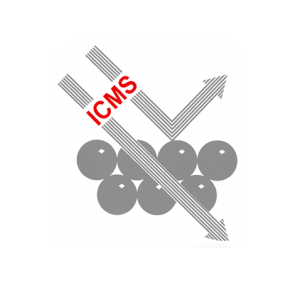Scientific Papers in SCI
2022
2022
Materiales de Diseño para la Energía y Medioambiente
Transparent, UV-blocking, and high barrier cellulose-based bioplastics with naringin as active food packaging materials
Guzman-Puyol, S; Hierrezuelo, J; Benitez, JJ; Tedeschi, G; Porras-Vazquez, JM; Heredia, A; Athanassiou, A; Romero, D; Heredia-Guerrero, JAInternational Journal of Biological Macromolecules, 209 (2022) 1985-1994 DOI: 10.1016/j.ijbiomac.2022.04.177
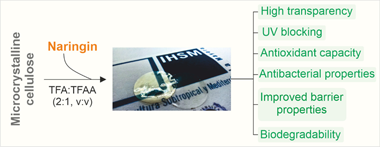
Abstract
Free-standing, robust, and transparent bioplastics were obtained by blending cellulose and naringin at different proportions. Optical, thermal, mechanical, antioxidant, and antimicrobial properties were systematically investigated. In general, the incorporation of naringin produced important UV blocking and plasticizer effects and good antioxidant and antibacterial properties. Moreover, the barrier properties were characterized by determination of their water and oxygen transmission rates, finding that both parameters decreased by increasing the naringin content and reaching values similar to other petroleum-based plastics and cellulose derivatives used for food packaging applications. Finally, the biodegradability of these films was determined by measurement of the biological oxygen demand (BOD) in seawater, demonstrating an excellent decomposition in such conditions.
May, 2022 · DOI: 10.1016/j.ijbiomac.2022.04.177
Composition and technological features of ceramics manufactured by Benito de Valladares in the seventeenth century from the Alcazar Palace in Seville, Spain
Pérez-Rodríguez, J.L.; Robador, M.D.; Duran, A.European Physical Journal Plus, 137 (2022) 469 DOI: 10.1140/epjp/s13360-022-02669-9
Abstract
The walls of the Alcazar Palace in Seville have been covered with ceramic tiles of different styles that were manufactured with different techniques. Several studies have been carried out on these ceramics, but no interest has been paid to the tiles manufactured by the workshop of the Valladares family, one of the most productive ceramic workshops in Triana (Seville). In this work, tiles that were made in the Valladares workshop are studied for the first time. The tiles from the Cenador del Leon built in 1645-1646 were chosen. The experimental studies suggest that the ceramic body was manufactured with silico-calcareous clay. This raw material was heated to a temperature of ca. 900 degrees C. A nondestructive and on-site analytical procedure was applied first. Microsamples were also taken and studied through microanalytical techniques. The maiolica style was used by Benito de Valladares for tile manufacture. The glaze phases were constituted by two layers. The pigments and doping elements used to obtain different colors were characterized. Valladares' work is considered as a continuation of Augusta's work; therefore, a comparison between both ceramists has been realized to better understand the ceramics production in southern Spain during the sixteenth to seventeenth centuries.
April, 2022 · DOI: 10.1140/epjp/s13360-022-02669-9
Nanotecnología en Superficies y Plasma
Thin film nanostructuring at oblique angles by substrate patterning
Muñoz-Pina, S; Alcaide, AM; Limones-Ahijon, B; Oliva-Ramirez, M; Rico, V; Alcala, G; Gonzalez, MU; García-Martín, JM; Alvarez, R; Wang, D; Schaaf, P; Gonzalez-Elipe, AR; Palmero, ASurface & Coatings Technology, 436 (2022) 128293 DOI: 10.1016/j.surfcoat.2022.128293
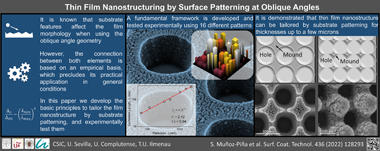
Abstract
It is demonstrated that, besides classical nanocolumnar arrays, the oblique angle geometry induces the growth of singular structures in the nanoscale when using wisely designed patterned substrates. Well-ordered array of crosses, cylindrical nanorods or hole structures arranged in square or hexagonal regular geometries are reported as examples, among others. The fundamental framework connecting substrate topography and film growth at oblique angles is presented, allowing the use of substrate patterning as a feasible thin film nanostructuring technique. A systematic analysis of the growth of TiO2 thin films on 4 different lithographic patterned substrates in 4 different scale lengths is also presented. A first conclusion is the existence of a height-based selective growth in the initial stages of the deposition, by which the film preferentially develops on top of the tallest substrate features. This behavior is maintained until the film reaches a critical thickness, the so-called Oblivion Thickness, above which the film topography becomes gradually independent of the substrate features. A general formula relating the spatial features of the pattern, the coarsening exponent and the Oblivion Thickness has been deduced.
April, 2022 · DOI: 10.1016/j.surfcoat.2022.128293
Reactividad de Sólidos
Ageing-resistant zirconia/graphene-based nanostructures composites for use as biomaterials
Morales-Rodriguez, A; Gonzalez-Orellana, C; Perez-Garcia, AA; Lopez-Pernia, C; Munoz-Ferreiro, C; Poyato, R; Gallardo-Lopez, AJournal of the European Ceramic Society, 42 (2022) 1784-1795 DOI: 10.1016/j.jeurceramsoc.2021.11.060
Abstract
This work explores the incorporation of graphene-based two-dimensional nanostructures as moisture barriers to delay hydrothermal ageing of yttria-stabilized zirconia and strengthen its use in biomedical applications. Two sets of highly dense zirconia composites incorporating multilayered graphene with very different lateral dimensions, few layer graphene and exfoliated graphene nanoplatelets, were prepared. The effect of the addition of graphene nanostructures on zirconia ageing was investigated by conducting accelerated hydrothermal degradation experiments in an autoclave. An improved resistance to low-temperature degradation and a high tolerance to damage were achieved in the composites compared to those of monolithic zirconia. The incorporation of 1 vol% multilayered graphene was very effective in restricting the hydrothermal degradation. In particular, the composite incorporating exfoliated graphene nanosheets exhibited outstanding resistance to ageing because of their fine dispersion throughout the matrix, which effectively seemed to restrict grain growth and slow the propagation of the transformation front to the ceramic bulk.
April, 2022 · DOI: 10.1016/j.jeurceramsoc.2021.11.060
Materiales Ópticos Multifuncionales
Transparent Phosphor Thin Films Based on Rare-Earth-Doped Garnets: Building Blocks for Versatile Persistent Luminescence Materials
Castaing, V; Lozano, G; Míguez, HAdvanced Photonics Research, 3 (2022) 2100367 DOI: 10.1002/adpr.202100367
Abstract
Afterglow properties of persistent phosphors are attracting a great deal of attention in the fields of bioimaging, sensing, labeling, safety, or security. Complex garnet oxides, especially those doped with Ce3+ and Cr3+, are particularly relevant to this end since their persistent luminescence can be tuned through matrix composition and activated by visible light, in contrast to the vast majority of persistent phosphors that require UV excitation. Most extended preparation routes yield micrometer-sized phosphors that display strong light scattering, which limits their versatility and applicability. Herein, nanostructured garnet oxide-based thin films that are transparent and feature persistent luminescence properties are demonstrated. Following a sol–gel route and after high temperature annealing, few hundred nanometre-thick Y3Al2Ga3O12:Ce3+,Cr3+ transparent films showing efficient green emission and afterglow are attained. Gd3Al2Ga3O12:Ce3+,Cr3+ transparent thin films displaying yellow afterglow with distinct persistent kinetics are demonstrated, to prove the generality of the approach herein proposed. Its versatility is further demonstrated by developing layered phosphors with time-dependent chromaticity due to the unique persistent emission color – upon blue light excitation – and kinetics of each layer forming the stack. The results pave an avenue toward nanodevices and multifunctional coatings in which afterglow offers hitherto unexplored properties.
April, 2022 · DOI: 10.1002/adpr.202100367
Materiales y Procesos Catalíticos de Interés Ambiental y Energético
H2 Photoproduction Efficiency: Implications of the Reaction Mechanism as a Function of the Methanol/Water Mixture
Barba-Nieto, I; Colon, G; Kubacka, A; Fernandez-Garcia, MCatalysts, 12 (2022) 402 DOI: 10.3390/catal12040402
Abstract
The influence of the reaction pathway of the sacrificial molecule oxidation to generate hydrogen is here investigated for lean and rich methanol reaction mixtures. Pt-TiO2 powders promoted or not with tin sulfide were used as catalysts. With the help of in situ infrared experiments under reaction conditions, methanol evolution was shown to take place by hole-related oxidation steps, with alkoxy and carbon-centered species as key radical species. The study analyzed quantitatively the fate and chemical use of the photons absorbed by the solids with the help of the quantum efficiency and the useful fraction of photons observables. Within this framework, the role of the sulfide component to promote photoactivity is interpreted, braiding chemical and photonic information.
April, 2022 · DOI: 10.3390/catal12040402
Química de Superficies y Catálisis
3D-printed structured catalysts for CO2 methanation reaction: Advancing of gyroid-based geometries
Gonzalez-Castano, M; Baena-Moreno, F; De Miguel, JCN; Miah, KUM; Arroyo-Torralvo, F; Ossenbrink, R; Odriozola, JA; Benzinger, W; Hensel, A; Wenka, A; Arellano-García, HEnergy Conversion and Management, 258 (2022) 115464 DOI: 10.1016/j.enconman.2022.115464
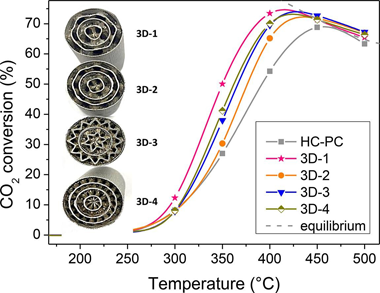
Abstract
This work investigates the CO2 methanation rate of structured catalysts by tuning the geometr y of 3D-printed metal Fluid Guiding Elements (FGEs) structures based on periodically variable pseudo-gyroid geometries. The enhanced performance showed by the structured catalytic systems is mostly associated with the capability of the FGEs substrate geometries for efficient heat usages. Thus, variations on the channels diameter resulted in ca. 25% greater CO2 conversions values at intermediate temperature ranges. The highest void fraction evidenced in the best performing catalyst (3D-1) favored the radial heat transfer and resulted in significantly enhanced catalytic activity, achieving close to equilibrium (75%) conversions at 400 ? and 120 mL/min. For the 3D-1 catalyst, a mathematical model based on an experimental design was developed thus enabling the estimation of its behavior as a function of temperature, spatial velocity, hydrogen to carbon dioxide (H-2/CO2) ratio, and inlet CO2 concentration. Its optimal operating conditions were established under 3 different scenarios: 1) no restrictions, 2) minimum H-2:CO2 ratios, and 3) minimum temperatures and H-2/CO2 ratio. For instance, for the lattest scenario, the best CO2 methanation conditions require operating at 431 ?, 200 mL/min, H-2/CO2 = 3 M ratio, and inlet CO2 concentration = 10 %.
April, 2022 · DOI: 10.1016/j.enconman.2022.115464
Nanotecnología en Superficies y Plasma
QUEELS: Software to calculate the energy loss processes in TEELS, REELS, XPS and AES including effects of the core hole
Tougaard, S; Pauly, N; Yubero, FSurface and Interface Analysis, 54 (2022) 820-833 DOI: 10.1002/sia.7095
Abstract
We present the user-friendly and freely available software package QUEELS (QUantitative analysis of Electron Energy Losses at Surfaces) that allows to calculate effective inelastic scattering cross sections within the dielectric response description, for swift electrons travelling nearby surfaces in several environments. We briefly describe the underlying theoretical models and illustrate its use to evaluate the distribution of energy losses taking place in electron spectroscopies like transmission electron energy loss spectroscopy (TEELS), X-ray photoelectron spectroscopy (XPS), Auger electron spectroscopy (AES) and reflection electron energy loss spectroscopy (REELS), which are widely used for material analysis. This includes the intrinsic excitations due to the core hole in XPS and AES.
April, 2022 · DOI: 10.1002/sia.7095
Reactividad de Sólidos
Highly uniform Y3Al2Ga3O12-based nanophosphors for persistent luminescence bioimaging in the visible and NIR regions
Arroyo, E; Herrero, BT; De la Fuente, JM; Ocaña, M; Becerro, AIInorganic Chemistry Frontiers, 9 (2022) 2454-2461 DOI: 10.1039/d2qi00480a
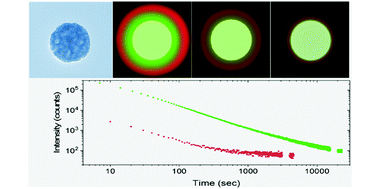
Abstract
In the last few years, persistent phosphors with a garnet crystal structure have attracted a great deal of interest for a plethora of applications ranging from bioimaging to anti-counterfeiting technologies. However, the development of synthesis methods to fabricate uniform garnet-based micro and nanoparticles, that are needed for such applications, is not mature at all. This study reports the synthesis of highly uniform yttrium aluminum gallium garnet nanospheres. The method is based on homogeneous precipitation in a polyol medium followed by silica coating and calcination. The nanoparticles resulting after silica removal were also uniform and were easily functionalized with polyacrylic acid. The colloidal stability of the latter in physiological media and their biocompatibility were analyzed. The luminescence of the particles, doped with Ce3+, Cr3+, and Nd3+, was studied by recording emission and excitation spectra and persistent luminescence decay curves. Due to their uniform morphology, high colloidal stability, absence of toxicity, and persistent emission in the visible and near-infrared regions, the reported nanospheres show great potential as persistent luminescent bioimaging probes. In addition, the synthesis method paves the way for future use of this persistent material in other applications that require the phosphor to be in the form of highly uniform nanoparticles.
April, 2022 · DOI: 10.1039/d2qi00480a
Fotocatálisis Heterogénea: Aplicaciones
Fast photodegradation of rhodamine B and caffeine using ZnO-hydroxyapatite composites under UV-light illumination
KarimTanji, J.A.Navio, Abdellah Chaqroune, Jamal Naja, F.Puga, M.C.Hidalgo, AbdelhakKherbecheCatalysis Today, 388 (2022) 176-186 DOI: 10.1016/j.cattod.2020.07.044
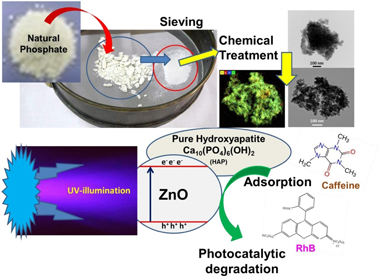
Abstract
Zinc oxide-hydroxyapatite composites were prepared using wet impregnation method. Firstly, a natural phosphate ore rich in silica and calcium phosphate was sieved to separate silica phase from phosphate phase. Then, through a chemical precipitation method, a pure hydroxyapatite (HAP) was obtained, which was used as a support for ZnO immobilization and applied for the photodegradation of two toxic contaminants: a transparent molecule (caffeine) and dye molecule (rhodamine B). During the present work two weight ratio percentages of zinc oxide were used: 25 wt.% and 50 wt.% of ZnO relative to HAP. The samples were characterized by X-ray diffraction (XRD), Fourier Transform Infrared (FTIR), X-ray Fluorescence (XRF), BET surface area (SBET), Scanning Electron Microscopy (SEM-EDS) and by Transmission Electron Microscopy (TEM-STEM). The immobilization of ZnO on HAP surface followed by thermal treatment at 400 °C for 2 h to get a homogenous dispersion of ZnO on the hydroxyapatite support. At high ZnO impregnation percentage, photodegradation performances of ZnO-HAP under UV illumination were fast and superior than the ZnO photocatalyst alone. The results showed that due to the presence of HAP, the conversion of both molecules became faster and greater, since it promotes the synergic phenomena of adsorption and photocatalysis. The toxicity of the treated substrate solutions obtained in the corn kernels germination test indicated a low toxicity after the photodegradation processes, probably due to a high mineralization degree.
April, 2022 · DOI: 10.1016/j.cattod.2020.07.044
Fotocatálisis Heterogénea: Aplicaciones
Z-scheme WO3/PANI heterojunctions with enhanced photocatalytic activity under visible light: A depth experimental and DFT studies
Y. Naciri; A.Hsini; A.Bouziani; K.Tanji; B.El Ibrahimi; M.N.Ghazza; B. Bakiz; A.Albourine; A.Benlhachemi; J.A. NavíoChemosphere, 292 (2022) 133468 DOI: 10.1016/j.chemosphere.2021.133468
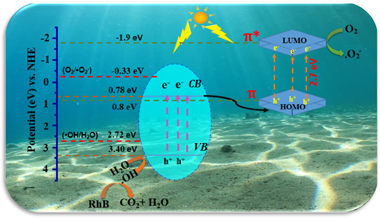
Abstract
A WO3@PANI heterojunction photocatalyst with a various mass ratio of polyaniline to WO3 was obtained via the in situ oxidative deposition polymerization of aniline monomer in the presence of WO3 powder. The characterization of WO3@PANI composites was carried via X-ray diffraction (XRD), scanning electron microscopy (SEM-EDS), transmission electron microscopy (TEM), Fourier transform infrared spectroscopy (FT-IR), ultraviolet–visible diffuse reflection spectroscopy (DRS), X-ray photoelectron spectroscopy (XPS) and photoluminescence spectroscopy (PL). The photocatalytic efficiency of WO3@PANI photocatalysts was assessed by following the decomposition of the Rhodamine B (RhB) dye under visible light irradiation (λ >420 nm). The results evidenced the high efficiency of the WO3@PANI (0.5 wt %) nanocomposite in the photocatalytic degradation of RhB (90% within 120 min) under visible light irradiation 3.6 times compared to pure WO3. The synergistic effect between PANI and WO3 is the reason for the increased photogenerated carrier separation. The superior photocatalytic performance of the WO3@PANI catalyst was ascribed to the increased visible light in the visible range and the efficient charge carrier separation. Furthermore, the Density Functional Theory study (DFT) of WO3@PANI was performed at the molecular level, to find its internal nature for the tuning of photocatalytic efficiency. The DFT results indicated that the chemical bonds connected the solid-solid contact interfaces between WO3 and PANI. Finally, a plausible photocatalytic mechanism of WO3@PANI (0.5 wt %) performance under visible light illumination is suggested to guide additional photocatalytic activity development.
April, 2022 · DOI: 10.1016/j.chemosphere.2021.133468
Nanotecnología en Superficies y Plasma
Ionomer-Free Nickel-Iron bimetallic electrodes for efficient anion exchange membrane water electrolysis
Lopez-Fernandez, E; Gomez-Sacedon, C; Gil-Rostra, J; Espinos, JP; Gonzalez-Elipe, AR; Yubero, F; De Lucas-Consuegra, AChemical Engineering Journal, 433 (2022) 133774 DOI: 10.1016/j.cej.2021.133774
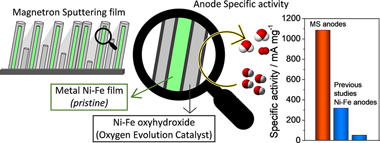
Abstract
A bottleneck for the deployment of the Anion Exchange Membrane Water Electrolysis (AEMWE) is the manufacturing of efficient and long lasting anodes and cathodes for the cells. Highly performant bimetallic Ni/Fe catalyst films with various atomic ratios have been prepared by magnetron sputtering in an oblique angle configuration (MS-OAD) and used as anodes for AEMWE. Electrocatalytic experiments in a small three-electrode cell and a thorough analysis of the electrode properties with various physico-chemical characterization tech-niques have been used to select the nanostructured anode catalyst which, depicting an optimized Ni/Fe ratio, presents the maximum activity for the oxygen evolution reaction. These anode layers are then scale-up for their integration in an AEMWE cell where the influence of assembly conditions and the effect of adding an ionomer to the anodes have been studied. The obtained results have demonstrated the outstanding properties of the fabri-cated bimetallic films in terms of activity, stability, and operation under ionomer-free conditions. Current density values around 400 and 600 mA cm(-2) at 40??& nbsp;and 60 C (2.0 V), respectively, much higher than those obtained with pure Ni, were obtained with an optimized membrane electrode assembly. The high yield obtained with these electrodes gains further relevance when considering that the current yield per unit mass of the anodic active phase catalyst (i.e., 1086 mA mg(-1) at 2.0 V and 40??) is the highest among equivalent values reported in literature. The possibilities and prospects of the use of bimetallic catalyst films prepared by MS-OAD for AEMWE are discussed.
April, 2022 · DOI: 10.1016/j.cej.2021.133774
Materiales Ópticos Multifuncionales
Enhanced up-conversion photoluminescence in fluoride-oxyfluoride nanophosphor films by embedding gold nanoparticles
Ngo, TT; Lozano, G; Miguez, HMaterials Advances 3 (2022) 4235-4242 DOI: 10.1039/D2MA00068G
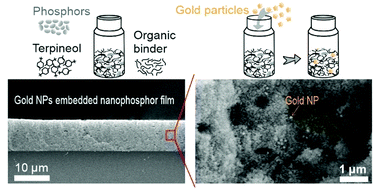
Abstract
Owing to their unique non-linear optical character, lanthanide-based up-converting materials are potentially interesting for a wide variety of fields ranging from biomedicine to light harvesting. However, their poor luminescent efficiency challenges the development of technological applications. In this context, localized surface plasmon resonances (LSPRs) have been demonstrated as a valuable strategy to improve light conversion. Herein, we utilize LSPR induced by gold nanoparticles (NPs) to enhance up-conversion photoluminescence (UCPL) in transparent, i.e. scattering-free, films made of nanophosphors formed by fluoride–oxyfluoride host matrix that feature high thermal stability. Transparency allows excitation by an external source without extinction losses caused by unwanted diffuse reflection. We provide a simple method to embed gold NPs in films made of YF/YOF:Yb3+,Er3+ UC nanophosphors, via preparation of a viscous paste composed of both UC nanophosphors and colloidal gold NPs, reducing complexity in sample fabrication. The dimensions of gold NPs are such that their associated LSPR matches spectrally with the green emission band of the Er3+ doped nanophosphors. In order to demonstrate the benefits of plasmonic nanoparticles for UCPL in nanophosphor films, we provide a careful analysis of the structural properties of the composite thin films along with precise characterization of the impact of the gold NPs on the photophysical properties of UC nanophosphors.
April, 2022 · DOI: 10.1039/D2MA00068G
Fotocatálisis Heterogénea: Aplicaciones
Insights into the structural and physicochemical properties of Zn-Bi-O composites for efficient photodegradation of caffeic acid, rhodamine B and methyl orange
F.Puga; J.A.Navío; J.M.Córdoba; F.Romero-Sarria; M.C.HidalgoApplied Surface Science, 581 (2022) 152351 DOI: 10.1016/j.apsusc.2021.152351
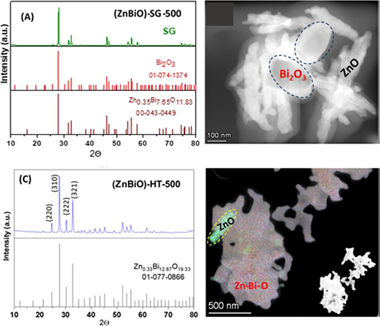
Abstract
Different Zn-Bi-O composites were synthesized following the starting chemical molar composition of ZnBi2O4 spinels by a sol–gel method, (ZnBiO)-SG, and its subsequent hydrothermal treatment, (ZnBiO)-HT. The acquired X-ray diffractograms after sequential thermal treatments at a programmed rate indicate that both precursors evolved, after calcination at 500 °C, to materials (ZnBiO) with different stoichiometry. The use of different characterization techniques (both FT-IR and TEM), allowed us to establish that, with the sol–gel process a mixed ZnO/Bi2O3 oxide is generated, while after hydrothermal process a ternary Zn-Bi-O oxide is formed, with small amounts of residual ZnO. The photocatalytic properties of the synthesized samples were evaluated using Caffeic acid, Rhodamine B and Methyl Orange as model substrates. It can be concluded that both catalysts showed excellent photocatalytic activity for the degradation of trans-caffeic acid under both UV and visible illumination. The leaching process (in particular of zinc), which is produced with the illumination time (in particular under UV illumination) in the presence of oxygen, raises the hypothesis of a foreseeable formation of complexes (photochemically stable or unstable) of caffeic acid with Zn2+ and Bi3+ ions. The plausible donor/acceptor interactions between the toxic molecules studied and the Zn2+ and Bi3+ ions, could condition the degradation processes, by means of a photoassisted process that would take place both, in the heterogeneous (photocatalytic) and homogeneous (photoassisted) phases. For the degradation processes of Rhodamine B and Methyl Orange, additional experimental conditions are studied that significantly improved their photocatalytic degradation.
April, 2022 · DOI: 10.1016/j.apsusc.2021.152351
Materiales de Diseño para la Energía y Medioambiente
Structural analysis of mixed alpha- and beta-amyrin samples
Gomez-Pulido, LDM; Gonzalez-Cano, RC; Benitez, JJ; Dominguez, E; Heredia, ARoyal Society Open Science, 9 (2022) 211787 DOI: 10.1098/rsos.211787
Abstract
Little is known about the structure and molecular arrangement of alpha- and beta-amyrin, a class of triterpenoids found within the cuticle of higher plants. Blends of both amyrin isomers with different ratios have been studied taking into consideration a combined methodology of density functional theory (DFT) calculations with experimental data from scanning electron microscopy, differential scanning calorimetry and Raman vibrational spectroscopy. Results indicate that trigonal trimeric aggregations of isomer mixtures are more stable, especially in the 1 : 2 (alpha : beta) ratio. A combination of Raman spectroscopy and DFT calculations has allowed to develop an equation to determine the amount of beta-amyrin in a mixed sample.
April, 2022 · DOI: 10.1098/rsos.211787
Materiales de Diseño para la Energía y Medioambiente
Insight into the role of temperature, time and pH in the effective zirconium retention using clay minerals
Pavon, E; Alba, MDJournal of Environmental Chemical Engineering, 308 (2022) 114635 DOI: 10.1016/j.jenvman.2022.114635
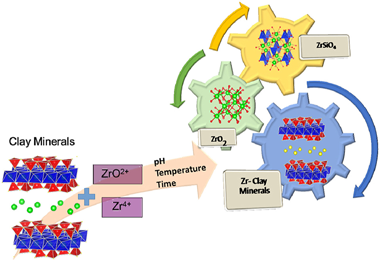
Abstract
The use of zirconium in chemical industries generates a potential risk of Zr contamination in the environment, with particular concern for the decommissioning of uranium-graphite reactors. Among the natural adsorbents employed for the treatment of nuclear waste, clay minerals showed a very high affinity adsorption for radionuclides, but the influence of the chemical composition, pressure, temperature and time reaction have not yet been analysed on deep. Thus, the objective of this research is to explore several experimental conditions for an actual prediction of the behaviour of zirconium immobilization by clay minerals. The results have shown that factors such as zirconium cation nature (Zr4+ or ZrO2+), temperature, time and pH influence the extent of zirconium immobilization by clay minerals and the zirconium phases generated. At moderate conditions, zirconium tectosilicates are formed and evolve to zircon at high temperature and a longer time reaction.
April, 2022 · DOI: 10.1016/j.jenvman.2022.114635
Materiales para Bioingeniería y Regeneración Tisular
Mesoporous Silica-Based Nanoparticles as Non-Viral Gene Delivery Platform for Treating Retinitis Pigmentosa
Valdes-Sanchez, L; Borrego-González, S; Montero-Sanchez, A; Massalini, S; De la Cerda, B; Díaz-Cuenca, A; Díaz-Corrales, FJJournal of Clinical Medicine, 11 (2022) 2170 DOI: 10.3390/jcm11082170
Abstract
Background: Gene therapy is a therapeutic possibility for retinitis pigmentosa (RP), in which therapeutic transgenes are currently delivered to the retina by adeno-associated viral vectors (AAVs). Although their safety and efficacy have been demonstrated in both clinical and preclinical settings, AAVs present some technical handicaps, such as limited cargo capacity and possible immunogenicity in repetitive doses. The development of alternative, non-viral delivery platforms like nanoparticles is of great interest to extend the application of gene therapy for RP. Methods: Amino-functionalized mesoporous silica-based nanoparticles (N-MSiNPs) were synthesized, physico-chemically characterized, and evaluated as gene delivery systems for human cells in vitro and for retinal cells in vivo. Transgene expression was evaluated by WB and immunofluorescence. The safety evaluation of mice subjected to subretinal injection was assessed by ophthalmological tests (electroretinogram, funduscopy, tomography, and optokinetic test). Results: N-MSiNPs delivered transgenes to human cells in vitro and to retinal cells in vivo. No adverse effects were detected for the integrity of the retinal tissue or the visual function of treated eyes. N-MSiNPs were able to deliver a therapeutic transgene candidate for RP, PRPF31, both in vitro and in vivo. Conclusions: N-MSiNPs are safe for retinal delivery and thus a potential alternative to viral vectors.
April, 2022 · DOI: 10.3390/jcm11082170
Materiales de Diseño para la Energía y Medioambiente
Strength and thermal shock resistance of fiber-bonded Si-Al-C-O and Si-Ti-C-O ceramics
Vera, MC; Martinez-Fernandez, J; Singh, M; Ramirez-Rico, JInternational Journal of Applied Ceramic Technology, 19 (2022) 1126-1135 DOI: 10.1111/ijac.13928
Abstract
Silicon carbide-based fiber-bonded ceramics, obtained from hot pressing of woven silicon carbide fibers, are a cost-effective alternative to ceramic-matrix composites due to their ease of fabrication, involving few processing steps, and competitive thermomechanical properties. In this work, we studied the high-temperature strength and thermal shock resistance of Si-Al-C-O and Si-Ti-C-O fiber-bonded SiC ceramics obtained from hot pressing of two types of ceramic fibers, by mechanical testing in four-point bending. The bending strength of Si-Al-C-O-based fiber-bonded ceramics at room temperature is similar to 250-260 MPa and remains constant with temperature, while the bending strength of Si-Ti-C-O increases slightly from the initial 220 to similar to 250 MPa for the highest temperature. Both materials retain up to 90% of their room temperature strength after thermal shocks of 1400 degrees C and show no reduction in elastic moduli. After thermal shock, failure mode is the same as in the case of as-received materials.
March, 2022 · DOI: 10.1111/ijac.13928
Reactividad de Sólidos
A novel Multi-Phase Flash Sintering (MPFS) technique for 3D complex-shaped ceramics
Molina-Molina, S; Gil-Gonzalez, E; Duran-Olivencia, FJ; Valverde, JM; Perejon, A; Sanchez-Jimenez, PE; Pérez-Maqueda, LAApplied Materials Today, 26 (2022) 101274 DOI: 10.1016/j.apmt.2021.101274
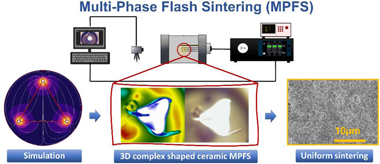
Abstract
This work demonstrates the first proof-of-concept of Multi-Phase Flash Sintering (MPFS). This novel technique essentially consists of applying a rotating electric field to the sample by means of a multi-phase voltage source as furnace temperature increases. Several ceramic materials with different types of electrical conductivities are sintered within seconds at furnace temperatures much lower than those used for traditional DC flash sintering due to the higher power densities administered by a multi-phase power supply. Thus, ceramic materials are flashed at relatively lower applied voltages which minimizes undesired phenomena such as localization and preferential current pathways. Furthermore, MPFS allows diverse electrode configurations to promote a more uniform electric field distribution, enhancing the sintering of 3D complex-shaped specimens. MPFS could be a true breakthrough in materials processing, as 3D complex-shaped specimens are homogeneously sintered at reduced temperatures, while keeping all the advantages of conventional flash sintering.
March, 2022 · DOI: 10.1016/j.apmt.2021.101274
Nanotecnología en Superficies y Plasma
Multiscale ultrafast laser texturing of marble for reduced surface wetting
Ariza, R; Alvarez-Alegria, M; Costas, G; Tribaldo, L; Gonzalez-Elipe, AR; Siegel, J; Solis, JApplied Surface Science, 577 (2022) 152850 DOI: 10.1016/j.apsusc.2021.151850
Abstract
The modification of the wetting properties of marble surfaces upon multi-scale texturing induced by ultrafast laser processing (340 fs pulse duration, 1030 nm wavelength) has been investigated with the aim of evaluating its potential for surface protection. The contact angle (CA) of a water drop placed on the surface was used to assess the wettability of the processed areas. Although the surfaces are initially hydrophilic upon laser treatment, after a few days they develop a strong hydrophobic behavior. Marble surfaces have been irradiated with different scan line separations to elucidate the relative roles of multi-scale roughness (nano-and micro-texture) and chemical changes at the surface. The time evolution of the contact angle has been then monitored up to 11 months after treatment. A short and a long-term evolution, associated to the combined effect of multi-scale roughness and the attachment of chemical species at the surface over the time, have been observed. XPS and ATR measurements are consistent with the progressive hydroxylation of the laser treated surfaces although the additional contribution of hydrocarbon adsorbates to the wettability evolution cannot be ruled-out. The robustness of the results has been tested by CA measurements after cleaning in different conditions with very positive results.
March, 2022 · DOI: 10.1016/j.apsusc.2021.151850
Nanotecnología en Superficies y Plasma
Rhodamine 6G and 800 intermolecular heteroaggregates embedded in PMMA for near-infrared wavelength shifting
Castillo-Seoane, J; Gonzalez-García, L; Obrero-Pérez, JM; Aparicio, FJ; Borras, A; Gonzalez-Elipe, AR; Barranco, A; Sanchez-Valencia, JRJournal of Materials Chemistry C, 10 (2022) 7119-7131 DOI: 10.1039/d1tc06167d
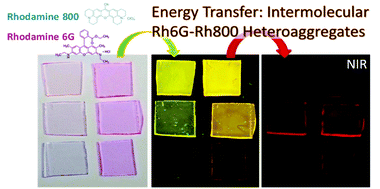
Abstract
The opto-electronic properties of small-molecules and functional dyes usually differ when incorporated into solid matrices with respect to their isolated form due to an aggregation phenomenon that alters their optical and fluorescent properties. These spectroscopic modifications are studied in the framework of the exciton theory of aggregates, which has been extensively applied in the literature for the study of molecular aggregates of the same type of molecules (homoaggregation). Despite the demonstrated potential of the control of the heteroaggregation process (aggregation of different types of molecules), most of the reported works are devoted to intramolecular aggregates, complex molecules formed by several chromophores attached by organic linkers. The intramolecular aggregates are specifically designed to hold a certain molecular structure that, on the basis of the exciton theory, modifies their optical and fluorescent properties with respect to the isolated chromophores that form the molecule. The present article describes in detail the incorporation of Rhodamine 6G (Rh6G) and 800 (Rh800) into polymeric matrices of poly-(methyl methacrylate), PMMA. The simultaneous incorporation of both dyes results in an enhanced fluorescent emission in the near-infrared (NIR), originating from the formation of ground-state Rh6G-Rh800 intermolecular heteroaggregates. The systematic control of the concentration of both rhodamines provides a model system for the elucidation of the heteroaggregate formation. The efficient energy transfer between Rh6G and Rh800 molecules can be used as wavelength shifters to convert effectively the light from visible to NIR, a very convenient wavelength range for many practical applications which make use of inexpensive commercial detectors and systems.
March, 2022 · DOI: 10.1039/d1tc06167d
Química de Superficies y Catálisis
Analysis of Dry Reforming as direct route for gas phase CO2 conversion. The past, the present and future of catalytic DRM technologies
le Sache, E; Reina, TRProgress in Energy and Combustion Science, 89 (2022) 100970 DOI: 10.1016/j.pecs.2021.100970
Abstract
Transition to low carbon societies requires advanced catalysis and reaction engineering to pursue green routes for fuels and chemicals production as well as CO2 conversion. This comprehensive review provides a fresh perspective on the dry reforming of methane reaction (DRM) which constitutes a straightforward approach for effective CO2 conversion to added value syngas. The bottleneck for the implementation of this process at industrial scale is the development of highly active and robust heterogeneous catalysts able to overcome the CO2 activation barrier and deliver sufficient amount of the upgrading products at the desired operation conditions. Also, its high energy demand due to the endothermic nature of the reaction imposes extra difficulties. This review critically discusses the recent progresses on catalysts design ranging from traditional metal-supported catalysts to advanced structured and nanostructured systems with promising performance. The main advantages and culprits of the different catalytic systems are introduced aiming to inspire the catalysis community to further refine these formulations towards the development of "supercatalysts" for DRM. Besides the design of increasingly complex catalyst morphologies as well as other promising alternatives aiming at reducing the energy consumption of the process or tackle deactivation through reactor design are introduced.
March, 2022 · DOI: 10.1016/j.pecs.2021.100970
Materiales y Procesos Catalíticos de Interés Ambiental y Energético
Research on properties and catalytic behaviour in CO hydrogenation at atmospheric and high pressure of bimetallic systems (10%Co+0.5%Pd)/TiO2 (Al2O3)
Shopska, M; Caballero, A; Platero, F; Todorova, S; Tenchev, K; Fabian, M; Aleksieva, K;Kolev, H; Kadinov, GReaction Kinetics Mechanisms and Catalysis, 135 (2022) 589-618 DOI: 10.1007/s11144-022-02194-x
Abstract
The properties of prereduced (10%Co + 0.5%Pd)/Al2O3 (TiO2) systems in the CO hydrogenation reaction at atmospheric and high pressure were studied. At atmospheric pressure, alumina-supported catalysts were more selective toward methane but those using titania were more active. Alumina containing samples demonstrated high temperature H-2 desorption, firmly held surface carbonate species, high tendency to agglomeration. During the reaction metal surface reconstruction and increased formation of CH2 groups occurred being more pronounced with titania-supported catalysts. Stability tests at 250 degrees C showed opposite behaviour of both systems. Monodentate carbonate intermediates adsorbed on sites of moderate strength prevailed on titania samples, while formate species predominated on high strength sites of alumina-supported catalysts. High pressure catalytic tests revealed dependence of activity on T-red, synthesis of C2+ hydrocarbons, decreased CO2 production, a higher CH4/CO2 ratio for alumina containing system. Due to SMSI, increased CO2 production on titania samples was preserved. Titania-supported catalysts revealed a stronger decrease of CO conversion rising T-red while alumina catalysts had almost unchanged activity. CO conversion decreased with time due to difficulties in surface diffusion of reagents/intermediates/products and metal particle agglomeration. Concerning T-red comparison of product distribution showed a steady trend. Because of stable CO and CHx surface species, titania containing catalysts produced lower content of C5+ compounds. Alumina-supported samples showed a higher selectivity to C5+ compounds at the expense of methane. A higher selectivity ratio for CH4 and CO2 determined in catalytic CO hydrogenation over a certain catalyst at atmospheric pressure could indicate that a given sample is predisposed to form C2+ hydrocarbons at a higher pressure.
March, 2022 · DOI: 10.1007/s11144-022-02194-x
Nanotecnología en Superficies y Plasma - Materiales Nanoestructurados y Microestructura
Highly Anisotropic Organometal Halide Perovskite Nanowalls Grown by Glancing-Angle Deposition
Castillo-Seoane, J; Contreras-Bernal, L; Obrero-Perez, JM; Garcia-Casas, X; Lorenzo-Lazaro, F; Aparicio, FJ; Lopez-Santos, C; Rojas, TC; Anta, JA; Borras, A; Barranco, A; Sanchez-Valencia, JRAdvanced Materials (2022) 2107739 DOI: 10.1002/adma.202107739
Abstract
Polarizers are ubiquitous components in current optoelectronic devices as displays or photographic cameras. Yet, control over light polarization is an unsolved challenge, since the main drawback of the existing display technologies is the significant optical losses. In such a context, organometal halide perovskites (OMHP) can play a decisive role given their flexible synthesis with tunable optical properties such as bandgap and photoluminescence, and excellent light emission with a low non-radiative recombination rate. Therefore, along with their outstanding electrical properties have elevated hybrid perovskites as the material of choice in photovoltaics and optoelectronics. Among the different OMHP nanostructures, nanowires and nanorods have lately arisen as key players in the control of light polarization for lighting or detector applications. Herein, the fabrication of highly aligned and anisotropic methylammonium lead iodide perovskite nanowalls by glancing-angle deposition, which is compatible with most substrates, is presented. Their high alignment degree provides the samples with anisotropic optical properties such as light absorption and photoluminescence. Furthermore, their implementation in photovoltaic devices provides them with a polarization-sensitive response. This facile vacuum-based approach embodies a milestone in the development of last-generation polarization-sensitive perovskite-based optoelectronic devices such as lighting appliances or self-powered photodetectors.
March, 2022 · DOI: 10.1002/adma.202107739
Química de Superficies y Catálisis
Understanding the promotional effect of Pt/CeO2 in cobalt-catalyzed Fischer-Tropsch synthesis using operando infrared spectroscopy at moderated pressures
Bobadilla, LF; Egana, A; Castillo, R.; Romero-Sarria, F.; Centeno, M.A.; Sanz, O.; Montes, M.; Odriozola, J.A.FUEL, 312 (2022) 122964 DOI: 10.1016/j.fuel.2021.122964
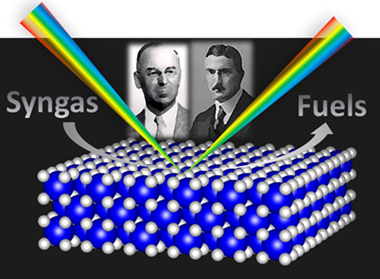
Abstract
Fischer-Tropsch (FTS) reaction is a well-known catalytic process for the conversion of synthesis gas into liquid fuels. The addition of a water gas shift (WGS) catalyst to the FTS one has been postulate to notably increase the efficiency of the process. In order to investigate this issue, we conducted the FTS reaction over a Co-Re/Al2O3 catalyst combined with an optimal WGS Pt/CeO2 catalyst. We observed a notable increase of CO conversion in presence of the Pt/CeO2 catalyst that a priori could be attributed to the WGS reaction. However, the WGS reaction is unfavourable at pressures higher than 1 bar and CO/CO2 hydrogenation over Pt/CeO2 could be more favoured under FTS reaction conditions. In order to gain insights on this fact and elucidate the role of Pt/CeO2 in the FTS reaction we have performed an operando DRIFTS-MS study under close FTS reaction conditions at 4 bar over the Pt/CeO2 catalyst.
March, 2022 · DOI: 10.1016/j.fuel.2021.122964
Materiales y Procesos Catalíticos de Interés Ambiental y Energético
Preferential CO oxidation in hydrogen-rich gases over Ag catalysts supported on different supports
Todorova, S; Kolev, H; Karakirova, Y; Filkova, D; Grahovski, B; Aleksieva, K; Holgado, JP; Kadinov, G; Caballero, AReaction Kinetics Mechanisms and Catalysis, 135 (2022) 1405-1422 DOI: 10.1007/s11144-022-02158-1
Abstract
The monometallic silver supported on SiO2, Al2O3, ZSM-5 (Si:Al = 100) and bi-metallic AgCe/SiO2 samples were studied in the reaction of the preferential CO oxidation. It was established that the supported silver catalysts are promising systems for selective oxidation of CO at low temperatures and the addition of cerium oxide increases the catalytic activity and selectivity most probably because of the increase in the silver dispersion; the homogeneous distribution of Ag and ceria on the silica support; formation of Ag-n(delta+) clusters; increase in bulk and subsurface oxygen.
March, 2022 · DOI: 10.1007/s11144-022-02158-1
Reactividad de Sólidos
Predictions of polymer thermal degradation: relevance of selecting the proper kinetic model
Sanchez-Jimenez, PE; Perejon, A; Arcenegui-Troya, J; Perez-Maqueda, LAJournal of Thermal Analysis and Calorimetry, 147 (2022) 2335-2341 DOI: 10.1007/s10973-021-10649-x
Abstract
Making predictions, such as lifetime estimations, is one of the main objectives of kinetic studies. Thus, from conventional thermal analysis experiments, the behavior of polymeric materials under processing or application conditions, usually far away from those used in the laboratory experiments, could be estimated. Conventional prediction procedures usually make use of oversimplified equations based on simple approaches. One of the most common approaches is the assumption of a first, or n-order, kinetic model for the process. However, recent studies have shown, for a number of polymers, that random scission kinetic models are not only physically sound, but more reliable in terms of describing the degradation kinetics. In this paper, the consequences of selecting an erroneous kinetic model on lifetime predictions is discussed. It is demonstrated, using both simulated and experimental data, that any kinetic analysis of a chain scission driven reaction performed assuming a first-order model entails enormous deviations in predictions. This occurs despite the fact that the first-order kinetic model can fit experimental data from chain scission driven reactions with significant correlation coefficients, and even lead to a reasonably good reconstruction of the original experimental curves.
February, 2022 · DOI: 10.1007/s10973-021-10649-x
Materiales de Diseño para la Energía y Medioambiente
Iron-catalyzed graphitization for the synthesis of nanostructured graphitic carbons
Hunter, RD; Ramirez-Rico, J; Schnepp, ZJournal of Materials Chemistry A, 10 (2022) 4489-4516 DOI: 10.1039/d1ta09654k
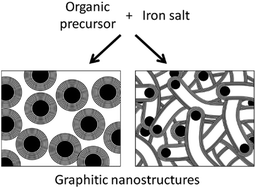
Abstract
Carbons are versatile and diverse materials that have numerous applications across energy and environmental sciences. Carbons with a graphitic structure are particularly appealing due to their high chemical stability, large surface areas and high thermal and electronic conductivity. Numerous methods exist to produce nanostructured graphitic carbons but some of these can be energy-intensive and/or have problems with scalability. One option that is being increasingly explored is the process of iron-catalyzed graphitization. This simply involves the pyrolysis of carbon-rich precursors in the presence of an iron catalyst and has been used to produce carbons with a wide range of structures and properties. This review will examine the current field of iron-catalyzed graphitization, with a focus on molecular organic or biomass precursors. Bio-derived precursors are particularly attractive as a potential option for sustainable production of graphitic carbons. We start with a brief introduction to some key carbon structures, the current applications in which they are employed and some of the key methods that have been developed to produce nanostructured graphitic carbons. We will then review the history of catalytic graphitization before evaluating the wide range of conditions and precursors that have been employed in catalytic graphitization. Finally, this review will investigate the current challenges facing iron-catalyzed graphitization, looking particularly at the limitations of the current understanding of the mechanistic aspects of graphitization, with a view to outlining where research in this field might progress.
February, 2022 · DOI: 10.1039/d1ta09654k
Nanotecnología en Superficies y Plasma
Plasma assisted CO2 dissociation in pure and gas mixture streams with a ferroelectric packed-bed reactor in ambient conditions
Navascues, P; Cotrino, J; Gonzalez-Elipe, AR; Gomez-Ramirez, AChemical Engineering Journal, 430 (2022) 133066 DOI: 10.1016/j.cej.2021.133066
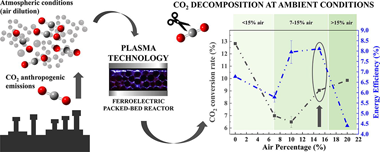
Abstract
Carbon dioxide decomposition is a challenging target to combat climate change. Nonthermal plasmas are advantageous for this purpose because they operate at ambient conditions and can be easily scaled-up. In this study, we attempt the CO2 splitting into CO and O-2 in a parallel plate packed-bed plasma reactor moderated with Lead Zirconate Titanate (PZT) as fermelectric component, achieving conversion rates and energy efficiencies higher than those obtained with BaTiO3 in our experimental device. The analysis of the reaction mechanisms with optical emission spectroscopy under various operating conditions has shown a direct correlation between energy efficiency and intensity of CO* emission bands. These results and those obtained with a LiNbO3 plate placed onto the active electrode suggest that high temperature electrons contribute to the splitting of CO2 through an enhancement in the formation of CO2+ intermediate species. Results obtained for CO2 + O-2 mixtures confirm this view and suggest that back recombination processes involving CO and O-2 may reduce the overall splitting efficiency. The study of mixtures of CO2 and dry air has proved the capacity of fermelectric packed-bed reactors to efficiently decompose CO2 with no formation of harmful NxOy subproducts in conditions close to those in real facilities. The found enhancement in energy efficiency with respect to that found for the pure gas decomposition supports that new reaction pathways involving nitrogen molecules are contributing to the dissociation reaction. We conclude that PZT moderated packed-bed plasma reactors is an optimum alternative for the decompositon of CO2 in real gas flows and ambient conditions.
February, 2022 · DOI: 10.1016/j.cej.2021.133066
Fotocatálisis Heterogénea: Aplicaciones
Exploring the photocatalytic activities of a highly {0 0 1} faceted TiO2 sensitized by coupling with AgBr or Ag3PO4
F.Puga; J.A.Navío; M.A.Paulete-Romero; J.M.Córdoba; M.C.HidalgoMaterials Science and Engineering: B, 276 (2022) 115555 DOI: 10.1016/j.mseb.2021.115555
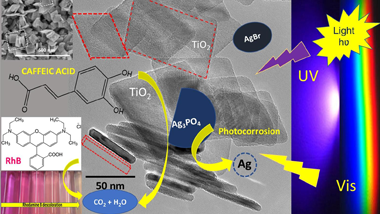
Abstract
TiO2 with high {0 0 1} facet exposure was coupled with AgBr or Ag3PO4. Catalysts were widely characterized and tested with rhodamine B (RhB) or caffeic acid under UV and visible light. Combination of the used sensitizer (AgBr or Ag3PO4) with TiO2, not only enhances the high photocatalytic activity shown in the UV for TiO2, but it also largely increases the degradation activity under visible illumination. A synergistic effect toward photocatalytic degradation in the visible light was observed when coupling AgBr and TiO2, with the photocatalytic degradation profiles being strongly related to the molar percentages of the coupled materials and to the nature of the contaminant. The recycling of the coupled materials allows us to conclude that the AgBr(50%)/TiO2 sample presents better results in the consecutive reuse cycles and percentages of RhB dye mineralization, in contrast to those observed for the Ag3PO4(50%)/TiO2 composite.
February, 2022 · DOI: 10.1016/j.mseb.2021.115555
Materiales de Diseño para la Energía y Medioambiente
The Response of Tomato Fruit Cuticle Membranes Against Heat and Light
Benitez, JJ; Moreno, AG; Guzman-Puyol, S; Heredia-Guerrero, JA; Heredia, A; Dominguez, EFrontiers in Plant Science, 12 (2022) 807723 DOI: 10.3389/fpls.2021.807723
Abstract
Two important biophysical properties, the thermal and UV-Vis screening capacity, of isolated tomato fruit cuticle membranes (CM) have been studied by differential scanning calorimetry (DSC) and UV-Vis spectrometry, respectively. A first order melting, corresponding to waxes, and a second order glass transition (T-g) thermal events have been observed. The glass transition was less defined and displaced toward higher temperatures along the fruit ripening. In immature and mature green fruits, the CM was always in the viscous and more fluid state but, in ripe fruits, daily and seasonal temperature fluctuations may cause the transition between the glassy and viscous states altering the mass transfer between the epidermal plant cells and the environment. CM dewaxing reduced the T-g value, as derived from the role of waxes as fillers. T-g reduction was more intense after polysaccharide removal due to their highly interwoven distribution within the cutin matrix that restricts the chain mobility. Such effect was amplified by the presence of phenolic compounds in ripe cuticle membranes. The structural rigidity induced by phenolics in tomato CMs was directly reflected in their mechanical elastic modulus. The heat capacity (Cp-rev) of cuticle membranes was found to depend on the developmental stage of the fruits and was higher in immature and green stages. The average Cp-rev value was above the one of air, which confers heat regulation capacity to CM. Cuticle membranes screened the UV-B light by 99% irrespectively the developmental stage of the fruit. As intra and epicuticular waxes contributed very little to the UV screening, this protection capacity is attributed to the absorption by cinnamic acid derivatives. However, the blocking capacity toward UV-A is mainly due to the CM thickness increment during growth and to the absorption by flavone chalconaringenin accumulated during ripening. The build-up of phenolic compounds was found to be an efficient mechanism to regulate both the thermal and UV screening properties of cuticle membranes.
January, 2022 · DOI: 10.3389/fpls.2021.807723
Química de Superficies y Catálisis
Metal micromonoliths for the cleaning of H-2 by means of methanation reactions
Laguna, OH; Munoz-Murillo, A; Bobadilla, LF; Martinez, LM; Montes, M; Centeno, MA; Odriozola, JACatalysis Today, 383 (2022) 216-225 DOI: 10.1016/j.cattod.2021.04.026
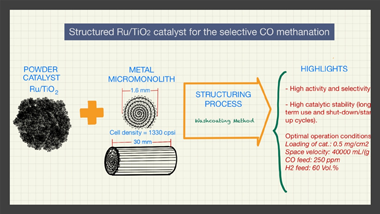
Abstract
The present manuscript presents for the first time the structuring of a Ru/TiO2 catalyst that was achieved by means of the washcoating procedure using homemade metal micromonoliths (Fecralloy (R)) of 1330 cpsi. For this, an optimized formulation of the slurried catalyst as well as a reproducible protocol for the coating of the micromonoliths were successfully achieved. The obtained structured systems were tested in the selective CO methanation reaction and the effect of different variables over the catalytic performance were analyzed such as the amount of loaded catalyst in the micromonoliths, the temperature of reaction, the space velocity, and the amount of CO and H-2 within the feed-stream. The study of all of these parameters allowed to establish optimal conditions to maximize the performance of the structured Ru/TiO2 catalyst and subsequently, this was tested under those cited conditions in long-term tests (similar to 375 h), including shut-down/start-up cycles, aiming to evaluate its catalytic stability. The system presented a considerable stability along the different test without loss of catalytic activity, being specially remarkable its resistance to the inclusion of shut-down/start-up cycles. Therefore, this study lays the foundations for future development of more sophisticated structured systems for the selective CO methanation based on the structuring strategy proposed.
January, 2022 · DOI: 10.1016/j.cattod.2021.04.026
Química de Superficies y Catálisis
Au and Pt Remain Unoxidized on a CeO2-Based Catalyst during the Water-Gas Shift Reaction
Reina, TR; Gonzalez-Castano, M; Lopez-Flores, V; Martinez, LMT; Zitolo, A; Ivanova, S; Xu, WQ; Centeno, MA; Rodriguez, JA; Odriozola, JAJournal of the American Chemical Society, 144 (2022) 446-453 DOI: 10.1021/jacs.1c10481
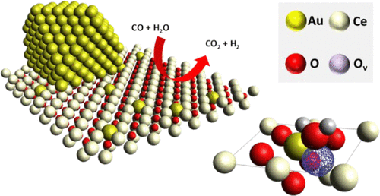
Abstract
The active forms of Au and Pt in CeO2-based catalysts for the water-gas shift (WGS) reaction are an issue that remains unclear, although it has been widely studied. On one hand, ionic species might be responsible for weakening the Ce-O bonds, thus increasing the oxygen mobility and WGS activity. On the other hand, the close contact of Au or Pt atoms with CeO2 oxygen vacancies at the metal-CeO2 interface might provide the active sites for an efficient reaction. In this work, using in situ X-ray absorption spectroscopy, we demonstrate that both Au and Pt remain unoxidized during the reaction. Remarkable differences involving the dynamics established by both species under WGS atmospheres were recognized. For the prereduced Pt catalyst, the increase of the conversion coincided with a restructuration of the Pt atoms into cuboctahedrical metallic particles without significant variations on the overall particle size. Contrary to the relatively static behavior of Pt-0, Au-0 nanoparticles exhibited a sequence of particle splitting and agglomeration while maintaining a zero oxidation state despite not being located in a metallic environment during the process. High WGS activity was obtained when Au atoms were surrounded by oxygen. The fact that Au preserves its unoxidized state indicates that the chemical interaction between Au and oxygen must be necessarily electrostatic and that such an electrostatic interaction is fundamental for a top performance in the WGS process.
January, 2022 · DOI: 10.1021/jacs.1c10481
Materiales Avanzados
Study of a Waste Kaolin as Raw Material for Mullite Ceramics and Mullite Refractories by Reaction Sintering
Sanchez-Soto, PJ; Eliche-Quesada, D; Martinez-Martinez, S; Perez-Villarejo, L; Garzon, EMaterials, 15 (2022) 583 DOI: 10.3390/ma15020583
Abstract
A deposit of raw kaolin, located in West Andalusia (Spain), was studied in this work using a representative sample. The methods of characterization were X-ray diffraction (XRD), X-ray fluorescence (XRF), particle size analysis by sieving and sedimentation, and thermal analysis. The ceramic properties were determined. A sample of commercial kaolin from Burela (Lugo, Spain), with applications in the ceramic industry, was used in some determinations for comparison purposes. The kaolin deposit has been produced by alteration of feldspar-rich rocks. This raw kaolin was applied as an additive in local manufactures of ceramics and refractories. However, there is not previous studies concerning its characteristics and firing properties. Thus, the meaning of this investigation was to conduct a scientific study on this subject and to evaluate the possibilities of application. The raw kaolin was washed for the beneficiation of the rock using water to increase the kaolinite content of the resultant material. The results indicated that the kaolinite content of the raw material was 20 wt % as determined by XRD, showing ~23 wt % of particles lower than 63 mu m. The kaolinite content of the fraction lower than 63 mu m was 50 wt %. Thus, an improvement of the kaolinite content of this raw kaolin was produced by wet separation. However, the kaolin was considered as a waste kaolin, with microcline, muscovite and quartz identified by XRD. Thermal analyses by Thermo-Dilatometry (TD), Differential Thermal Analysis (DTA) and Thermo-Gravimetry (TG) allowed observe kaolinite thermal decomposition, quartz phase transition and sintering effects. Pressed samples of this raw kaolin, the fraction lower than 63 mu m obtained by water washing and the raw kaolin ground using a hammer mill were fired at several temperatures in the range 1000-1500 & DEG;C for 2 h. The ceramic properties of all these samples were determined and compared. The results showed the progressive linear firing shrinkage by sintering in these samples, with a maximum value of ~9% in the fraction lower than 63 mu m. In general, water absorption capacity of the fired samples showed a decrease from ~18-20% at 1050 & DEG;C up to almost zero after firing at 1300 & DEG;C, followed by an increase of the experimental values. The open porosity was almost zero after firing at 1350 & DEG;C for 2 h and the bulk density reached a maximum value of 2.40 g/cm(3) as observed in the ground raw kaolin sample. The XRD examination of fired samples indicated that they are composed by mullite, from kaolinite thermal decomposition, and quartz, present in the raw sample, as main crystalline phases besides a vitreous phase. Fully-densified or vitrified materials were obtained by firing at 1300-1350 & DEG;C for 2 h. In a second step of this research, it was examined the promising application of the previous study to increase the amount of mullite by incorporation of alumina (alpha-alumina) to this kaolin sample. Firing of mixtures, prepared using this kaolin and alpha-alumina under wet processing conditions, produced the increase of mullite in relative proportion by reaction sintering at temperatures higher than 1500 & DEG;C for 2 h. Consequently, a mullite refractory can be prepared using this kaolin. This processing of high-alumina refractories is favoured by a previous size separation, which increases the kaolinite content, or better a grinding treatment of the raw kaolin.
January, 2022 · DOI: 10.3390/ma15020583
Nanotecnología en Superficies y Plasma
Plasma engineering of microstructured piezo-Triboelectric hybrid nanogenerators for wide bandwidth vibration energy harvesting
Garcia-Casas, X; Ghaffarinehad, A; Aparicio, FJ; Castillo-Seoane, J; Lopez-Santos, C; Espinos, JP; Cotrino, J; Sanchez-Valencia, JR; Barranco, A; Borras, ANano Energy, 91 (2022) 106673 DOI: 10.1016/j.nanoen.2021.106673
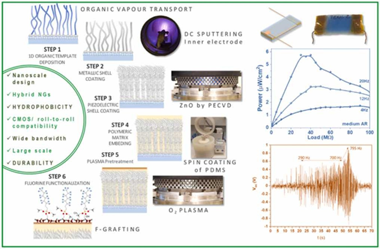
Abstract
We introduce herein the advanced application of low-pressure plasma procedures for the development of piezo and triboelectric mode I hybrid nanogenerators. Thus, plasma assisted deposition and functionalization methods are presented as key enabling technologies for the nanoscale design of ZnO polycrystalline shells, the formation of conducting metallic cores in core@shell nanowires, and for the solventless surface modification of polymeric coatings and matrixes. We show how the perfluorinated chains grafting of polydimethylsiloxane (PDMS) provides a reliable approach to increase the hydrophobicity and surface charges at the same time that keeping the PDMS mechanical properties. In this way, we produce efficient Ag/ZnO convoluted piezoelectric nanogenerators supported on flexible substrates and embedded in PDMS compatible with a contact-separation triboelectric architecture. Factors like crystalline texture, ZnO thickness, nanowires aspect ratio, and surface chemical modification of the PDMS are explored to optimize the power output of the nanogenerators aimed for harvesting from low-frequency vibrations. Just by manual triggering, the hybrid device can charge a capacitor to switch on an array of color LEDs. Outstandingly, this simple three-layer architecture allows for harvesting vibration energy in a wide bandwidth, thus, we show the performance characteristics for frequencies between 1 Hz and 50 Hz and demonstrate the successful activation of the system up to ca. 800 Hz.
January, 2022 · DOI: 10.1016/j.nanoen.2021.106673
Fotocatálisis Heterogénea: Aplicaciones
Visible light photodegradation of blue basic 41 using cobalt doped ZnO: Box–Behnken optimization and DFT calculation
K. Tanji; M. Zouheir; Y. Naciri; H. Ahmoum; A. Hsini; O. Mertah; A. El Gaidoumi; J.A. Navio; M.C. Hidalgo; A KherbecheJournal of the Iranian Chemical Society, 19 (2022) 2779-2794 DOI: 10.1007/s13738-022-02496-w
Abstract
CoxZn1−xO system (0 ≤ x ≤ 0.2) was synthesized using the solution combustion method with urea as a fuel source. Photocatalytic tests were performed under visible light to assess the Basic Blue 41 (BB41) conversion. Various characterization techniques, including XRD, FT-IR analysis, SEM, EDS, XRF, BET-surface area, and DRS were used to investigate the composition, structure, and morphology of the synthesized catalysts. In addition, the density functional theory calculation was used in order to study the electronic properties of the ZnO structure. The Box–Behnken model was valid for describing the degradation of BB41 dye according to the analysis of variances results. A maximum conversion of 100% for BB41 dye has been reached with high mineralization and important removal of chemical oxygen demand. The optimum conditions for BB41 conversion are reported. On the other hand, the reuse tests of the best catalyst showed high-performance stability after five cycles. Furthermore, the activity of superoxide ions (O2·−) and hydroxyl radicals (OH.) as the spices responsible for BB41 dye conversion was well confirmed by the free radicals scavenging tests. The use of Box–Behnken optimization and DFT calculation applied to the synthesized catalysts proves to be a very suitable procedure to establish the operating conditions under which the synthesis strategy of the CoxZn1−xO catalyst in its activity in the visible region performs an excellent efficiency for the degradation of organic dyes and makes contributions to the current literature related to the field of environmental technology.
January, 2022 · DOI: 10.1007/s13738-022-02496-w
Química de Superficies y Catálisis
Performance of AISI 316L-stainless steel foams towards the formation of graphene related nanomaterials by catalytic decomposition of methane at high temperature
Cazana, F; Latorre, N; Tarifa, P; Royo, CJ; Sebastian, V; Romeo, E; Centeno, MA; Monzon, ACatalysis Today, 383 (2022) 236-246 DOI: 10.1016/j.cattod.2020.12.003
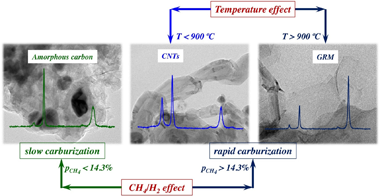
Abstract
This work explores the preparation of graphene-related materials (GRMs) grown on stainless steel foams via catalytic decomposition of methane (CDM). The main active phases for the reaction are the Fe nanoparticles segregated from the stainless-steel after the activation stage of the foam. The effect of the feed composition and reaction temperature has been studied in order to maximize the productivity, stability and selectivity to GRMs. The maximum productivity attained was 0.116 g(C)/g(foam) h operating at 950 degrees C with a feed ratio of CH4/H-2 = 3 (42.9 %CH4:14.3 %H-2). The carbonaceous nanomaterials (CNMs) obtained were characterized by X-Ray diffraction, Raman spectroscopy and by transmission and scanning electron microscopy. The parameters of the kinetic model developed are directly related to the relevant stages of the process, including carburization, diffusion-precipitation and deactivation-regeneration. The balance among these sequential stages determines the overall performance of the activated foam. In conditions of rapid carburization of the Fe NPs (p(CH4) > 14 %), the productivity to CNMs is favoured, avoiding an initial deactivation of the active sites by fouling with amorphous carbon. After a rapid carburization, the selectivity to the different CNMs is governed by the ratio CH4/H-2, and mainly by the temperature. Thus, the formation of GRMs, mainly Few Layer Graphene (FLG) and even graphene, is favoured at temperatures above 900 degrees C. At lower temperatures, carbon nanotubes are formed.
January, 2022 · DOI: 10.1016/j.cattod.2020.12.003
Química de Superficies y Catálisis
Enhanced catalytic activity and stability of nanoshaped Ni/CeO2 for CO2 methanation in micro-monoliths
Garcia-Moncada, N; Navarro, JC; Odriozola, JA; Lefferts, L; Faria, JACatalysis Today, 383 (2022) 205-215 DOI: 10.1016/j.cattod.2021.02.014
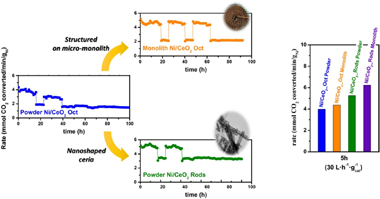
Abstract
Coupling inherently fluctuating renewable feedstocks to highly exothermic catalytic processes, such as CO2 methanation, is a major challenge as large thermal swings occurring during ON- and OFF- cycles can irreversible deactivate the catalyst via metal sintering and pore collapsing. Here, we report a highly stable and active Ni catalyst supported on CeO2 nanorods that can outperform the commercial CeO2 (octahedral) counterpart during CO2 methanation at variable reaction conditions in both powdered and mu-monolith configurations. The long-term stability tests were carried out in the kinetic regime, at the temperature of maximal rate (300 degrees C) using fluctuating gas hourly space velocities that varied between 6 and 30 L h- 1.gcat- 1. Detailed catalyst characterization by mu-XRF revealed that similar Ni loadings were achieved on nanorods and octahedral CeO2 (c.a. 2.7 and 3.3 wt. %, respectively). Notably, XRD, SEM, and HR-TEM-EDX analysis indicated that on CeO2 nanorods smaller NiClusters with a narrow particle size distribution were obtained (- 7 +/- 4 nm) when compared to octahedral CeO2 (- 16 +/- 13 nm). The fast deactivation observed on Ni loaded on commercial CeO2 (octahedral) was prevented by structuring the reactor bed on mu-monoliths and supporting the Ni catalyst on CeO2 nanorods. FeCrAlloy (R) sheets were used to manufacture a multichannel mu-monolith of 2 cm in length and 1.58 cm in diameter, with a cell density of 2004 cpsi. Detailed catalyst testing revealed that powdered and structured Ni/ CeO2 nanorods achieved the highest reaction rates, c.a. 5.5 and 6.2 mmol CO2 min- 1.gNi - 1 at 30 L h- 1.gcat- 1 and 300 degrees C, respectively, with negligible deactivation even after 90 h of fluctuating operation.
January, 2022 · DOI: 10.1016/j.cattod.2021.02.014
Química de Superficies y Catálisis
Unravelling the role of Fe in trimetallic Fe-Cu-Pt/Al2O3 catalysts for CO-PROX reaction
Palma, S; Gonzalez-Castano, M; Romero-Sarria, F; Odriozola, JAMolecular Catalysis, 517 (2022) 112015 DOI: 10.1016/j.mcat.2021.112015
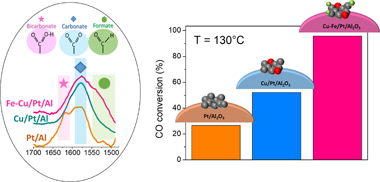
Abstract
This work proposes a trimetallic Fe-Cu/Pt/Al2O3 catalyst as an appealing system for preferential oxidation of CO (CO-PROX) reaction. The excellent conversion rates achieved by the Fe-Cu/Pt/Al2O3 catalysts under realistic reforming-surrogated feed streams along with the catalyst stability, reproducibility, and scalability showcase a very competitive system for CO-PROX reaction units. Furthermore, the systematic analysis conducted for Pt/Al2O3, Cu/Pt Al2O3, and Fe-Cu/Pt/Al2O3 catalysts enabled establishing meaningful relationships between catalytic behaviour and the catalyst surface to reactants interactions. Thus, the enhanced CO oxidation performances attained by the incorporation of Fe species into bimetallic Cu/Pt/Al2O3 catalysts were associated to superior surface electron densities and inhibited CO adsorption process over Pt surfaces. Remarkably, operando-DRIFTS spectroscopy evidenced significantly larger H-containing surface species developed over the trimetallic system. The enhanced abilities for developing thermally instable intermediates favoured by small amounts of Fe should indeed determine the enhanced catalysts behaviours displayed by the trimetallic Fe-Cu/Pt/Al2O3 catalyst.
January, 2022 · DOI: 10.1016/j.mcat.2021.112015
Nanotecnología en Superficies y Plasma - Tribología y Protección de Superficies
Compositional gradients at the nanoscale in substoichiometric thin films deposited by magnetron sputtering at oblique angles: A case study on SiOx thin films
Garcia-Valenzuela, A; Alcaide, AM; Rico, V; Ferrer, FJ; Alcala, G; Rojas, TC; Alvarez, R; González-Elipe, AR; Palmero, APlasma Processes and Polymers (2022) e2100116 DOI: 10.1002/ppap.202100116
Abstract
We demonstrate the existence of stoichiometric variations at the nanoscale when growing nanocolumnar SiOx thin films by reactive magnetron sputtering deposition at oblique angles. Results show stoichiometric variations in the range 0.3 < x < 1.3 when growing a SiO0.5 thin film. This agrees with results from a numerical growth model that obtains a shift of the stoichiometry in all nanocolumns from lower values at the side facing the Si target to higher values at the opposite side. The different momentum distribution of the gaseous reactive and sputtered species results in preferential incorporation of the latter at a particular side of the nanocolumns. The general occurrence of this mechanism during the reactive magnetron sputtering deposition of substoichiometric thin films at oblique angles is discussed.
January, 2022 · DOI: 10.1002/ppap.202100116
Reactividad de Sólidos
Flash Sintering Research Perspective: A Bibliometric Analysis
Gil-Gonzalez, E; Perez-Maqueda, LA; Sanchez-Jimenez, PE; Perejon, AMaterials, 15 (2022) 416 DOI: 10.3390/ma15020416
Abstract
Flash Sintering (FS), a relatively new Field-Assisted Sintering Technique (FAST) for ceramic processing, was proposed for the first time in 2010 by Prof. Rishi Raj's group from the University of Colorado at Boulder. It quickly grabbed the attention of the scientific community and since then, the field has rapidly evolved, constituting a true milestone in materials processing with the number of publications growing year by year. Moreover, nowadays, there is already a scientific community devoted to FS. In this work, a general picture of the scientific landscape of FS is drawn by bibliometric analysis. The target sources, the most relevant documents, hot and trending topics as well as the social networking of FS are unveiled. A separate bibliometric analysis is also provided for Reaction or Reactive Flash Sintering (RFS), where not only the sintering, but also the synthesis is merged into a single step. To the best of our knowledge, this is the first study of this nature carried out in this field of research and it can constitute a useful tool for researchers to be quickly updated with FS as well as to strategize future research and publishing approaches.
January, 2022 · DOI: 10.3390/ma15020416
Materiales Ópticos Multifuncionales
Molecular Interface Engineering via Triazatruxene-Based Moieties/NiOx as Hole-Selective Bilayers in Perovskite Solar Cells for Reliability
Hemasiri, NH; Calio, L; Pegu, M; Kazim, S; Ahmad, SSolar RRL (2022) 2100793 DOI: 10.1002/solr.202100793
Abstract
Interface engineering is an effective approach to decrease nonradiative recombination and the energy barrier at the perovskite/hole transporting layer (HTL) interfaces. To overcome such limitations, an organic semiconductor (DTT-EHDI2) is proposed, which is, composed of dithienothiophene (DTT) as the core and a planar triazatruxene incorporating an alkyl chain as the side group. This is noted to be an effective interfacial layer for inverted planar perovskite solar cells (PSCs). The altered interface effectively minimizes the detrimental charge recombination and tailors the photoinduced charge transfer dynamics at the interface of the inorganic HTL/perovskite. The pi-conjugation in DTT-EHDI2 induces high hole mobility and electrical conductivity via electron-donating properties and strong pi-pi intermolecular interaction. The synergetic approach leads to a substantial performance enhancement in dopant-free DTT-EHDI2-based inverted planar PSCs, achieving 18.15% power conversion efficiency with negligible hysteresis effect. The present approach provides an effective direction of the cost-effective thiophene derivative as an interfacial agent to escalate the optoelectronic performances in photovoltaics.
January, 2022 · DOI: 10.1002/solr.202100793
Nanotecnología en Superficies y Plasma
Coarse-grained approach to amorphous and anisotropic materials in kinetic Monte Carlo thin-film growth simulations: A case study of TiO2 and ZnO by plasma-enhanced chemical vapor deposition
Budagosky, J; Garcia-Casas, X; Sanchez-Valencia, JR; Barranco, A; Borras, APlasma Processes and Polymers (2022) e2100179 DOI: 10.1002/ppap.202100179
Abstract
The growth of TiO2 and ZnO thin films is studied by means of coarse-grained kinetic Monte Carlo simulations under conditions typically encountered in plasma-enhanced chemical vapor deposition experiments. The basis of our approach is known to work well to simulate the growth of amorphous materials using cubic grids and is extended here to reproduce not only the morphological characteristics and scaling properties of amorphous TiO2 but also the growth of polycrystalline ZnO with a good approximation, including the evolution of the film texture during growth and its dependence on experimental conditions. The results of the simulations have been compared with available experimental data obtained by X-ray diffraction, analysis of the texture coefficients, atomic force microscopy, and scanning electron microscopy.
January, 2022 · DOI: 10.1002/ppap.202100179
Materiales Ópticos Multifuncionales
Optoelectronic Devices Based on Scaffold Stabilized Black-Phase CsPbI3 Nanocrystals
Romero-Perez, C; Rubino, A; Calio, L; Calvo, ME; Miguez, HAdvanced Optical Materials (2022) 2102112 DOI: 10.1002/adom.202102112
Abstract
The optoelectronic properties of lead halide perovskites are intimately related to their crystalline phase. For the case of cesium lead iodide (CsPbI3) several polymorphs meet the Goldschmidt tolerance factor, which determines their stability, and form broad band absorber and luminescent phases. However, at room temperature none of them are stable, which prevents their use in optoelectronics. In this work, bare CsPbI3 nanocrystals are synthesized in the sub-10 nm range in the "black", light emitting, crystalline phase, using a pore controlled SiO2 matrix that limits crystal size and confers a certain degree of strain that favors their stability. Quantum confinement effects allow the tuning of the optical properties of the CsPbI3 nanocrystals by means of the crystal size. Their suitability as optoelectronic materials is demonstrated by building scaffold supported CsPbI3 quantum dot based photovoltaic and light emitting devices.
January, 2022 · DOI: 10.1002/adom.202102112
Reactividad de Sólidos
Effect of Steam Injection during Carbonation on the Multicyclic Performance of Limestone (CaCO3) under Different Calcium Looping Conditions: A Comparative Study
Troya, JJA; Moreno, V; Sánchez-Jiménez, PE; Perejon, A; Valverde, JM; Perez-Maqueda, LAACS Sustanaible Chemistry & Engineering, 10 (2022) 850-859 DOI: 10.1021/acssuschemeng.1c06314
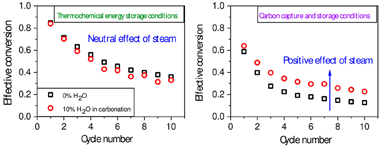
Abstract
This study explores the effect of steam addition during carbonation on the multicyclic performance of limestone under calcium looping conditions compatible with (i) CO2 capture from postcombustion gases (CCS) and with (ii) thermochemical energy storage (TCES). Steam injection has been proposed to improve the CO2 uptake capacity of CaO-based sorbents when the calcination and carbonation loops are carried out in CCS conditions: at moderate carbonation temperatures (similar to 650 degrees C) under low CO2 concentration (typically similar to 15% at atmospheric pressure). However, the recent proposal of calcium-looping as a TCES system for integration into concentrated solar power (CSP) plants has aroused interest in higher carbonation temperatures (similar to 800-850 degrees C) in pure CO2. Here, we show that steam benefits the multicyclic behavior in the milder conditions required for CCS. However, at the more aggressive conditions required in TCES, steam essentially has a neutral net effect as the CO2 uptake promoted by the reduced CO2 partial pressure but also is offset by the substantial steam-promoted mineralization in the high temperature range. Finally, we also demonstrate that the carbonation rate depends exclusively on the partial pressure of CO2, regardless of the diluting gas employed.
January, 2022 · DOI: 10.1021/acssuschemeng.1c06314
Química de Superficies y Catálisis
Structured and micro-structured catalysts: A fascinating future for a sustainable world – A special issue in tribute to the careers of Professors Mario Montes and José Antonio Odriozola
M.A.Centeno; L.M.Gandía; F.Romero-Sarria; O.SanzCatalysis Today, 383 (2022) 1-4 DOI: 10.1016/j.cattod.2021.09.034
Reactividad de Sólidos
Effect of the Processing Parameters on the Porosity and Mechanical Behavior of Titanium Samples with Bimodal Microstructure Produced via Hot Pressing
Chavez-Vasconez, R; Lascano, S; Sauceda, S; Reyes-Valenzuela, M; Salvo, C; Mangalaraja, RV; Gotor, FJ; Arevalo, C; Torres, YMaterials, 15 (2022) 136 DOI: 10.3390/ma15010136
Abstract
Commercially pure (c.p.) titanium grade IV with a bimodal microstructure is a promising material for biomedical implants. The influence of the processing parameters on the physical, microstructural, and mechanical properties was investigated. The bimodal microstructure was achieved from the blends of powder particles with different sizes, while the porous structure was obtained using the space-holder technique (50 vol.% of ammonium bicarbonate). Mechanically milled powders (10 and 20 h) were mixed in 50 wt.% or 75 wt.% with c.p. titanium. Four different mixtures of powders were precompacted via uniaxial cold pressing at 400 MPa. Then, the specimens were sintered at 750 degrees C via hot pressing in an argon gas atmosphere. The presence of a bimodal microstructure, comprised of small-grain regions separated by coarse-grain ones, was confirmed by optical and scanning electron microscopies. The samples with a bimodal microstructure exhibited an increase in the porosity compared with the commercially available pure Ti. In addition, the hardness was increased while the Young's modulus was decreased in the specimens with 75 wt.% of the milled powders (20 h).
January, 2022 · DOI: 10.3390/ma15010136
Nanotecnología en Superficies y Plasma
Plasma engineering of microstructured piezo-Triboelectric hybrid nanogenerators for wide bandwidth vibration energy harvesting
García-Casas, X; Ghaffarinehad, A; Aparicio, FJ; Castillo-Seoane, J; López-Santos, C; Espinós, JP; Cotrino, J; Sánchez-Valencia, JR; Barranco, A; Borrás, ANano Energy, 91 (2022) 106673 DOI: 10.1016/j.nanoen.2021.106673
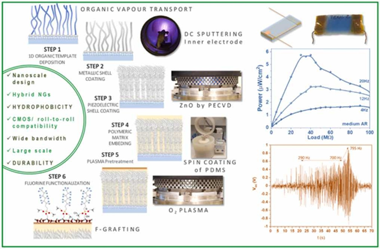
Abstract
We introduce herein the advanced application of low-pressure plasma procedures for the development of piezo and triboelectric mode I hybrid nanogenerators. Thus, plasma assisted deposition and functionalization methods are presented as key enabling technologies for the nanoscale design of ZnO polycrystalline shells, the formation of conducting metallic cores in core@shell nanowires, and for the solventless surface modification of polymeric coatings and matrixes. We show how the perfluorinated chains grafting of polydimethylsiloxane (PDMS) provides a reliable approach to increase the hydrophobicity and surface charges at the same time that keeping the PDMS mechanical properties. In this way, we produce efficient Ag/ZnO convoluted piezoelectric nanogenerators supported on flexible substrates and embedded in PDMS compatible with a contact-separation triboelectric architecture. Factors like crystalline texture, ZnO thickness, nanowires aspect ratio, and surface chemical modification of the PDMS are explored to optimize the power output of the nanogenerators aimed for harvesting from low-frequency vibrations. Just by manual triggering, the hybrid device can charge a capacitor to switch on an array of color LEDs. Outstandingly, this simple three-layer architecture allows for harvesting vibration energy in a wide bandwidth, thus, we show the performance characteristics for frequencies between 1 Hz and 50 Hz and demonstrate the successful activation of the system up to ca. 800 Hz.
January, 2022 · DOI: 10.1016/j.nanoen.2021.106673
Química de Superficies y Catálisis
Boosting water activation determining-step in WGS reaction on structured catalyst by Mo-doping
Garcia-Moncada, N; Jurado, L; Martinez-Tejada, LM; Romero-Sarria, F; Odriozola, JACatalysis Today, 383 (2022) 193-204 DOI: 10.1016/j.cattod.2020.06.003
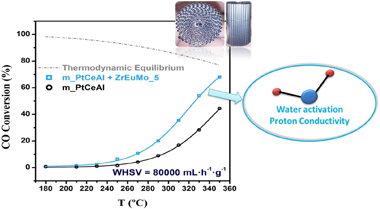
Abstract
Proton conductors Mo-Eu-Zr mixed oxide systems were synthesized and further mixed with a conventional Pt/CeO2/Al2O3 catalyst to develop a highly efficient water-gas-shift (WGS) catalyst. The designed catalyst, once structured, allows reach the equilibrium conversion at medium temperatures (similar to 350 degrees C) at 80 L.g(-1) h(-1) space velocity. The ability of the proton conductor to maintain an elevated water concentration at the metal-support interface by Grotthuss' mechanism boosts the catalytic activity in WGS reaction.
The Mo-containing proton conductor is extensively characterized allowing to establish the formation of molybdenum oxide phases nucleating on top of the Eu sites in Eu-Zr oxide solid solution. [MoO4](2-) to [Mo7O24](6-) clusters nucleates at low Mo contents resulting in a alpha-MoO3 layer on increasing its content. In presence of H-2, Mobronzes are formed from similar to 200 degrees C enhancing water concentration at the surfaces and boosting the catalytic activity in the WGS reaction. These results pave the way for developing lower volume WGS reactors.
January, 2022 · DOI: 10.1016/j.cattod.2020.06.003
2021
2021
Fotocatálisis Heterogénea: Aplicaciones
LaFeO3 Modified with Ni for Hydrogen Evolution Via Photocatalytic Glucose Reforming in Liquid Phase
G. Iervolino; V. Vaiano; D. Sannino; F. Puga; J.A. Navío; M.C. HidalgoCatalysts, 11 (2021) 1558 DOI: 10.3390/catal11121558
Abstract
In this work, the optimization of Ni amount on LaFeO3 photocatalyst was studied in the photocatalytic molecular hydrogen production from glucose aqueous solution under UV light irradiation. LaFeO3 was synthesized via solution combustion synthesis and different amount of Ni were dispersed on LaFeO3 surface through deposition method in aqueous solution and using NaBH4 as reducing agent. The prepared samples were characterized with different techniques: Raman spectroscopy, UltraViolet-Visible Diffuse Reflectance Spettroscopy (UV–Vis-DRS), X-ray Diffraction (XRD), X-ray Photoelectron Spectroscopy (XPS), X-ray Fluorescence (XRF), Transmission Electron microscopy (TEM), and Scanning Electron microscopy (SEM) analyses. For all the investigated photocatalysts, the presence of Ni on perovskite surface resulted in a better activity compared to pure LaFeO3. In particular, it is possible to identify an optimal amount of Ni for which it is possible to obtain the best hydrogen production. Specifically, the results showed that the optimal Ni amount was equal to nominal 0.12 wt% (0.12Ni/LaFeO3), for which the photocatalytic H2 production was equal to 2574 μmol/L after 4 h of UV irradiation. The influence of different of photocatalyst dosage and initial glucose concentration was also evaluated. The results of the optimization of operating parameters indicated that the highest molecular hydrogen production was achieved on 0.12Ni/LaFeO3 sample with 1.5 g/L of catalyst dosage and 1000 ppm initial glucose concentration. To determine the reactive species that play the most significant role in the photocatalytic hydrogen production, photocatalytic tests in the presence of different radical scavengers were performed. The results showed that •OH radical plays a significant role in the photocatalytic conversion of glucose in H2. Moreover, photocatalytic tests carried out with D2O instead of H2O evidenced the role of water molecules in the photocatalytic production of molecular hydrogen in glucose aqueous solution.
December, 2021 · DOI: 10.3390/catal11121558
Química de Superficies y Catálisis
In Situ DRIFTS-MS Methanol Adsorption Study onto Supported NiSn Nanoparticles: Mechanistic Implications in Methanol Steam Reforming
Bobadilla, LF; Azancot, L; Ivanova, S; Delgado, JJ; Romero-Sarria, F; Centeno, MA; Roger, ACNanomaterials, 11 (2021) 3234 DOI: 10.3390/nano11123234
Abstract
Methanol adsorption over both supported NiSn Nps and analogous NiSn catalyst prepared by impregnation was studied by in situ diffuse reflectance infrared Fourier transform spectroscopy (DRIFTS) to gain insights into the basis of hydrogen production from methanol steam reforming. Different intermediate species such as methoxides with different geometry (bridge and monodentate) and formate species were identified after methanol adsorption and thermal desorption. It is proposed that these species are the most involved in the methanol steam reforming reaction and the major presence of metal-support interface sites in supported NiSn Nps leads to higher production of hydrogen. On the basis of these results, a plausible reaction mechanism was elucidated through the correlation between the thermal stability of these species and the evolution of the effluent gas released. In addition, it was demonstrated that DME is a secondary product generated by condensation of methoxides over the acid sites of alumina support in an acid-catalyzed reaction.
December, 2021 · DOI: 10.3390/nano11123234
Materiales de Diseño para la Energía y Medioambiente
Mechanical Performances of Isolated Cuticles Along Tomato Fruit Growth and Ripening
Benitez, JJ; Guzman-Puyol, S; Vilaplana, F; Heredia-Guerrero, JA; Dominguez, E; Heredia, AFrontiers in Chemistry, 12 (2021) 787839 DOI: 10.3389/fpls.2021.787839
Abstract
The cuticle is the most external layer that protects fruits from the environment and constitutes the first shield against physical impacts. The preservation of its mechanical integrity is essential to avoid the access to epidermal cell walls and to prevent mass loss and damage that affect the commercial quality of fruits. The rheology of the cuticle is also very important to respond to the size modification along fruit growth and to regulate the diffusion of molecules from and toward the atmosphere. The mechanical performance of cuticles is regulated by the amount and assembly of its components (mainly cutin, polysaccharides, and waxes). In tomato fruit cuticles, phenolics, a minor cuticle component, have been found to have a strong influence on their mechanical behavior. To fully characterize the biomechanics of tomato fruit cuticle, transient creep, uniaxial tests, and multi strain dynamic mechanical analysis (DMA) measurements have been carried out. Two well-differentiated stages have been identified. At early stages of growth, characterized by a low phenolic content, the cuticle displays a soft elastic behavior. Upon increased phenolic accumulation during ripening, a progressive stiffening is observed. The increment of viscoelasticity in ripe fruit cuticles has also been associated with the presence of these compounds. The transition from the soft elastic to the more rigid viscoelastic regime can be explained by the cooperative association of phenolics with both the cutin and the polysaccharide fractions.
December, 2021 · DOI: 10.3389/fpls.2021.787839
Reactividad de Sólidos
Unravelling the optimization of few-layer graphene crystallinity and electrical conductivity in ceramic composites by Raman spectroscopy
Muñoz-Ferreiro, C; Lopez-Pernia, C; Gallardo-Lopez, A; Poyato, RJournal of the European Ceramic Society, 41 (2021) 290-298 DOI: 10.1016/j.jeurceramsoc.2021.09.025
Abstract
Zirconia composites with few-layer graphene (FLG) were prepared by two powder processing routines-ultrasonic agitation or planetary ball milling-and spark plasma sintered at 1250 and 1300 degrees C. An in-depth study of the crystallinity of FLG, in terms of presence and nature of defects, was performed by Raman spectroscopy, revealing enhanced FLG crystallinity after sintering. This enhancement was more noticeable in the composites sintered at the highest temperature, with lower amount of structural defects and amorphous carbon. However, remaining amorphous carbon was detected in the composites prepared by planetary ball milling even after sintering at the highest temperature, resulting in lower electrical conductivities. Optimum results in terms of electrical conductivity were achieved for the composites prepared by ultrasonic agitation and sintered at 1300 degrees C, with electrical percolation limit below 2.5 vol% FLG and high electrical conductivity (678 S/m for 5 vol% FLG), as result of the enhanced FLG crystallinity after sintering.
December, 2021 · DOI: 10.1016/j.jeurceramsoc.2021.09.025
Reactividad de Sólidos
Advanced parametrisation of phase change materials through kinetic approach
Lizana, J; Perejon, A; Sanchez-Jimenez, PE; Perez-Maqueda, LAJournal of Energy Storage, 44 (2021) 103441 DOI: 10.1016/j.est.2021.103441
Abstract
Phase change materials (PCM) have been widely investigated for heat storage and transfer applications. Numerous numerical simulation approaches have been proposed for modelling their behaviour and predicting their performance in thermal applications. However, simulation approaches do not consider the kinetics of the phase transition processes, compromising the accuracy of their predictions. The phase change is a kinetically driven process in which both the reaction rate and the reaction progress depend on the heating schedule. This work evaluates and parametrises the influence of kinetics in the melting and crystallisation behaviour of a well-known PCM, PEG1500, and compares potential discrepancies with common phase change parametrisation alternatives. The kinetic dependence was experimentally evaluated through differential scanning calorimetry (DSC). The kinetic parameters required for modelling the kinetics of the processes were determined by both model-free and model-fitting procedures following ICTAC (International Confederation for Thermal Analysis and Calorimetry) recommendations. Then, the phase transition was parametrised through a kinetic model and compared with three conventional phase transition models: linear without hysteresis, non-linear without hysteresis, and non-linear with hysteresis. The statistical comparison between models demonstrates the higher accuracy of the kinetic approach to correctly represent the partial enthalpy distribution of latent heat storage materials during alternative phase change rates, obtaining a coefficient of determination (R-2) of 0.80. On the other hand, the accuracy of kinetic-independent models is limited to the range from 0.40 to 0.61. The results highlight the high discrepancies of conventional models compared to the kinetic approach and provide criteria and guidelines for efficient kinetic modelling of phase change in heat transfer evaluations.
December, 2021 · DOI: 10.1016/j.est.2021.103441
Reactividad de Sólidos
Fabrication and characterization of FeCoNiCrMn,(Al) high entropy alloy based (Ti,Ta,Nb)(C,N) cermet
Real, C; Alcala, MD; Trigo, I; Fombella, I; Cordoba, JMInternational Journal of Refractory Metals & Hard Materials, 101 (2021) 105694 DOI: 10.1016/j.ijrmhm.2021.105694
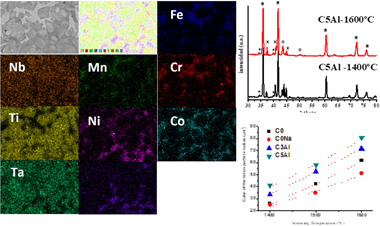
Abstract
From nanostructured mechanically synthesized powder a set of FeCoNiCrMn,(Al) based (Ti,Ta,Nb)(C,N) cermets were fabricated and sintered by a pressureless procedure. Highly dense cermets were obtained, and the nature of chemical change, microstructure, mechanical properties and coarsening kinetic of ceramic phase were characterized by image analysis, microindentation, scanning electron microscopy and X-ray diffraction. The design of the material was performed using a set of three different chemical cermet composition and three different sintering temperatures, or comparative purposes.
December, 2021 · DOI: 10.1016/j.ijrmhm.2021.105694
Materiales Coloidales
White, blue, violet, and other colors from Tm3+/Tb3+/Eu3+ co-doped polymorph SrAl2O4 films, deposited by ultrasonic spray pyrolysis technique
Calderon-Olvera, RM; Garcia-Hipolito, M; Alvarez-Fregoso, O; Alvarez-Perez, MA; Baez-Rodriguez, A; Ramos-Brito, F; Garcia-Velasco, AC; Falcony, COpticalls Materials DOI: 10.1016/j.optmat.2021.111737
Abstract
SrAl2O4: Tm3+, SrAl2O4: (Tb3+; Eu3+) and SrAl2O4: (Tb3+; Eu3+; Tm3+) films were deposited by ultrasonic spray pyrolysis (USP) method at 550. C and subsequently heat-treated at 800 degrees C. XRD characterization showed a monoclinic/hexagonal polymorph phase of these films with orthorhombic Sr4Al14O25 as secondary phase. The incorporation of Tm3+ ions in strontium aluminate host lattice generated emissions of blue color for photoluminescence and violet color for cathodoluminescence. The violet emission was associated to the electronic transition from I-1(6) energy level of Tm3+. Photoluminescence of the SrAl2O4: (Tb3+; Eu3+) films resulted in two different colors, white emission was observed when excited with 210 nm and bluish-white emission was achieved by exciting with 275, and 286 nm. When three dopant ions (Tm3+; Tb3+; Eu3+) were incorporated inside strontium aluminate host lattice, it was observed (exciting under 252 nm) white photoluminescence emission (x = 0.3377, y = 0.3294); for excitation wavelengths (lambda(exc)) = 262, 315 and 375 nm, emissions in different shades of blue-green were achieved. Quantum efficiencies between 48 and 57% were obtained.
December, 2021 · DOI: 10.1016/j.optmat.2021.111737
Materiales de Diseño para la Energía y Medioambiente
Designed organomicaceous materials for efficient adsorption of iodine
Osuna, FJ; Pavon, E; Pazos, MC; Alba, MDJournal of Environmental Chemical Engineering, 9 (2021) 106577 DOI: 10.1016/j.jece.2021.106577
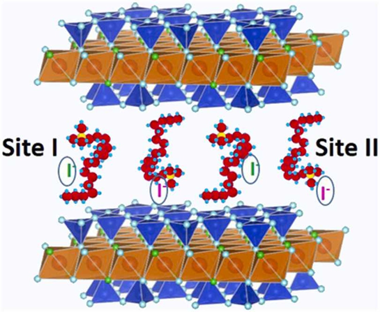
Abstract
The anionic iodine I-129 has a significant contribution to overall long-term dose resulting from the nuclear waste storage and its immobilization by clay barrier is crucial. Organoclays have been tested as ideal adsorption materials, being the clay layer charge and the length and type of organic molecules the most relevant parameters affecting the adsorption. In this work, a family of designed organomicas are explored in term of iodine adsorption capacity. Their adsorption capacities were always higher than that of the traditional clays and organoclays. C-18-M4 shows a maximum monolayer adsorption capacity one order of magnitude higher than natural organoclays, with a free energy typical of physical adsorption and adsorption sites of high affinity. However, its surface is not homogeneous in terms of stability constant according to the Scatchard adsorption parameters. Hence, this study can provide a guidance for the design and construction of ultrahigh-capacity iodine adsorbents.
December, 2021 · DOI: 10.1016/j.jece.2021.106577
Nanotecnología en Superficies y Plasma
Extraction of microstructural parameters from sculptured thin films nanoindentation
Gaillard, Y; Jimenez-Pique, E; Oliva-Ramirez, M; Rico, VJ; Gonzalez-Elipe, ARSurface & Coatings Technology, 425 (2021) 127696 DOI: 10.1016/j.surfcoat.2021.127696
Abstract
This work deals with the indentation analysis of nanocolumnar thin films and the difficulties encountered to deduce relevant mechanical parameters by this methodology. SiO2 thin films prepared by physical vapour oblique angle deposition with different nanocolumnar microstructures have been subjected to indentation analysis. Despite the fact that the films had been made of the same material, deposited on the same substrate and had similar thickness, their indentation responses were different and depended on their particular microstructure. It has been also realised that the measured hardness and elastic modulus variation with the indentation depth were length scale dependent and that there is not a unique analytical thin-film nanoindentation model to extract the mechanical properties from the experimental nanoindentation curves. To overcome these limitations a numerical finite element model (FEM) of the nanocolumnar coatings has been built to figure out the contributions of the different physical phenomena intervening in the indentation process. This FEM simulation relies on a description of the elasto-plastic microstructural units of the coatings and the contact friction interactions between them. Based on this simulation a parametrical representation, incorporating two length scales and the contributions of densification and/or the buckling of nanocolumnar units, has been developed to account for the evolution of the apparent elastic modulus deduced from numerical indentation tests. A Hall-Petch modification of this description considering two length scales instead of the common approximation considering a single length scale has rendered the best agreement with the elastic values determined experimentally. Although, at the present stage, the particular microstructure of the films can not be deduced from the evolution of their elastic moduli with the indentation depth, the obtained results and their interpretation constitute a first though essential step for the elaboration of an inverse analysis methodology capable of correlating microstructure and elastic response of nanocolumnar coatings.
November, 2021 · DOI: 10.1016/j.surfcoat.2021.127696
Materiales de Diseño para la Energía y Medioambiente
Impact of flame confinement with inert ceramic foams on the particulate emissions of domestic heating systems
Ciria, D; Orihuela, MP; Becerra, JA; Chacartegui, R.; Ramirez-Rico, J.Fuel, 304 (2021) 121264 DOI: 10.1016/j.fuel.2021.121264
Abstract
Small solid biomass combustion systems are among the main contributors to the global particulate emissions share, and cheap, efficient abatement systems are not yet available for them. The placement of inert porous material to confine the combustion region is being recently explored as a possible mitigation system for this kind of pollution. However, given the complexity of biomass thermochemical decomposition processes, it is challenging to justify the performance of these systems on the basis of a physicochemical understanding. A foundational experiment-based study is carried out in this work to understand how combustion confinement affects the particulate emissions production mechanisms. A combustion unit was designed and built to systematically test ceramic foams with different porosities: keeping constant airflow and fuel feed rates. A comprehensive characterisation study was carried out on the solid biomass fuel, the temperature profile, the particulate emissions, and the remaining solid residue. The results evidenced that the use of foams has a substantial impact on the temperature distribution in the combustion chamber. The higher the cell density of the foam, the higher and more homogeneous are the temperatures reached in the combustion bed. This fact improved the thermal decomposition process of the pellets due to a better air-fuel mixture, leading to a reduction of the solid particulate matter emissions by more than 70%. These findings suggest that the use of an inert porous material above the combustion region might be a feasible solution for particulate emission control in small-size biomass combustion technology.
November, 2021 · DOI: 10.1016/j.fuel.2021.121264
Química de Superficies y Catálisis
Assessing the impact of textural properties in Ni-Fe catalysts for CO2 methanation performance
Gonzalez-Castano, M; de Miguel, JCN; Boelte, JH; Centeno, MA; Klepel, O; Arellano-Garcia, HMicroporous and Mesoporous Materials, 327 (2021) 111405 DOI: 10.1016/j.micromeso.2021.111405
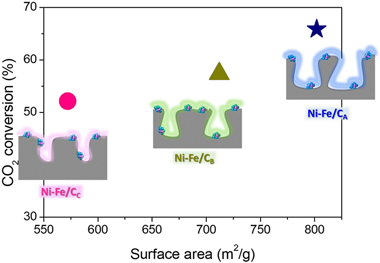
Abstract
In heterogeneous catalysis, the benefits of employing adequate textural properties on the catalytic performances are usually stated. Nevertheless, the quantification of the extent of improvement is not an easy task since variations on the catalysts' specific areas and pore structures might involve modifications on a number of other surface catalytic features. This study establishes the impact of the catalyst textural properties on the CO2 methanation performance by investigating bimetallic Ni–Fe catalysts supported over carbon supports with different textural properties regarding surface area and pore structure. The comparable metal loading and dispersions attained for all systems enabled establishing forthright relationships between the catalyst textural properties and CO2 methanation rate. Once the influence of the external mass diffusions on the catalysts’ performance was experimentally discarded, the estimated Thiele modulus and internal effectiveness (φ and ηEff) values showed that the catalyst performance was majorly governed by the surface reaction rate whilst the pore size affected in no significant manner within the examined range (Dpore = 10.2 to 5.8 nm). Therefore, the rapport between the catalyst performance and surface area was quantified for the CO2 methanation reaction over Ni–Fe catalysts: increasing the surface area from 572 to 802 m2/g permit obtaining ca. 10% higher CO2 conversions.
November, 2021 · DOI: 10.1016/j.micromeso.2021.111405
- ‹ previous
- 8 of 37
- next ›




